Creative production
Post-production workflow: the ultimate guide for video teams
October 2025
12 mins
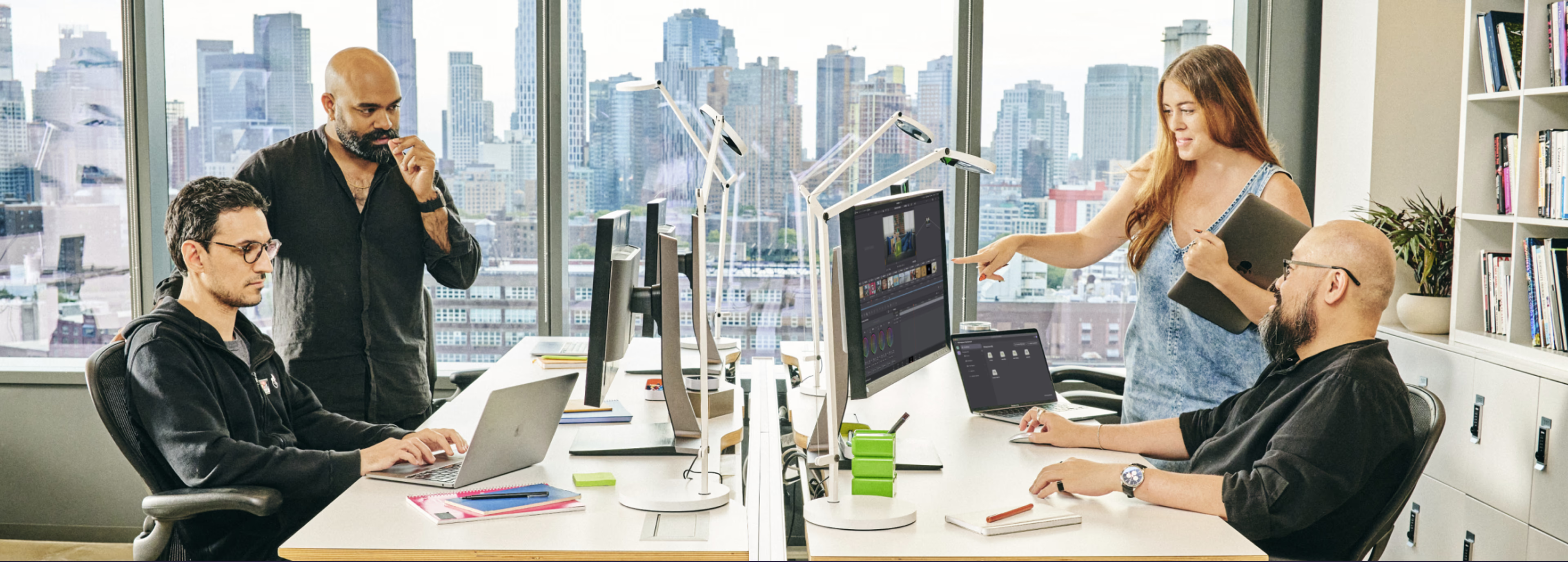
Table of contents
- What is a post-production workflow?
- The key steps in a post-production workflow
- Cloud-based post-production workflows
- How LucidLink transforms your post-production workflow
- 5 expert tips to optimize your post-production workflow
- A post-production workflow in action: 50 films in 5 weeks
- Post-production workflow software and tools
- How long does post-production usually last?
- The future of post-production workflows
- Ready to transform your post-production workflow?
Your files, faster.
Access any file instantly, anywhere. Collaborate in real-time from one always-up-to-date, secure cloud filespace.
Tight deadlines. Scattered teams. Files playing hide-and-seek.
Post-production is supposed to be where the magic happens. Not where projects hit a wall, slow to a crawl or blow the budget.
The solution? A smoother post-production workflow.
In this guide, we’ll break down the key stages of a post-production workflow — and show how a cloud-first approach helps creative teams move faster, stay in sync and hit every deadline.
What is a post-production workflow?
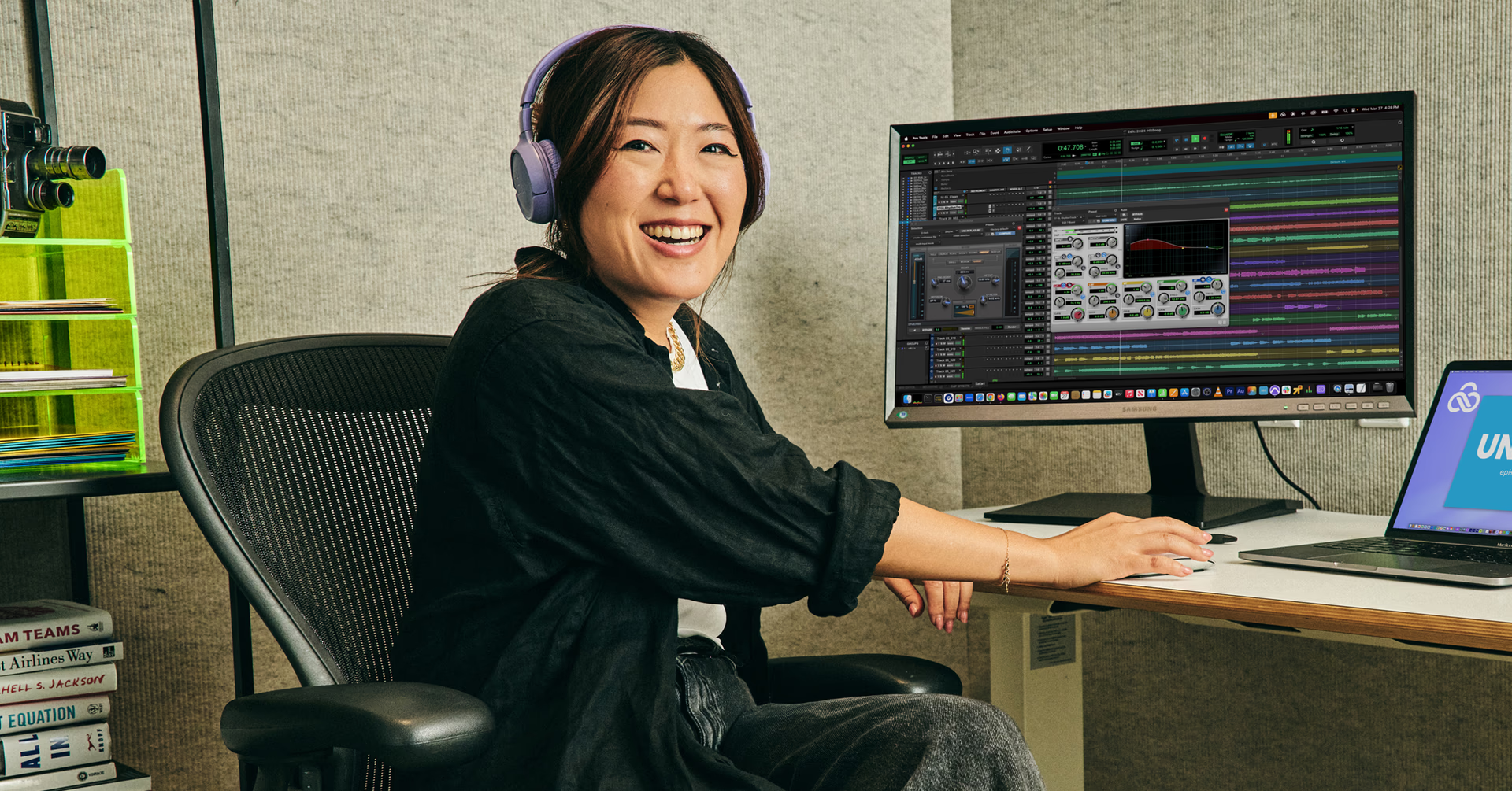
Your post-production workflow is where raw footage becomes a finished masterpiece.
It’s the last (and most vital) phase where everything comes together, whether you’re working on film editing, TV episodes, documentaries, commercials or any other kind of creative content.
It typically involves:
Organizing media
Video editing
Sound mixing
Visual effects (VFX),
Color correction and grading
Final export and delivery
A streamlined video post-production workflow cuts out the chaos, keeps your creative on-brand and speeds up production, without sacrificing quality.
The key steps in a post-production workflow
Post-production begins before the camera starts rolling. A structured workflow keeps everything moving, without creative bottlenecks.
Here's how to master each video post-production workflow step while avoiding common pitfalls:
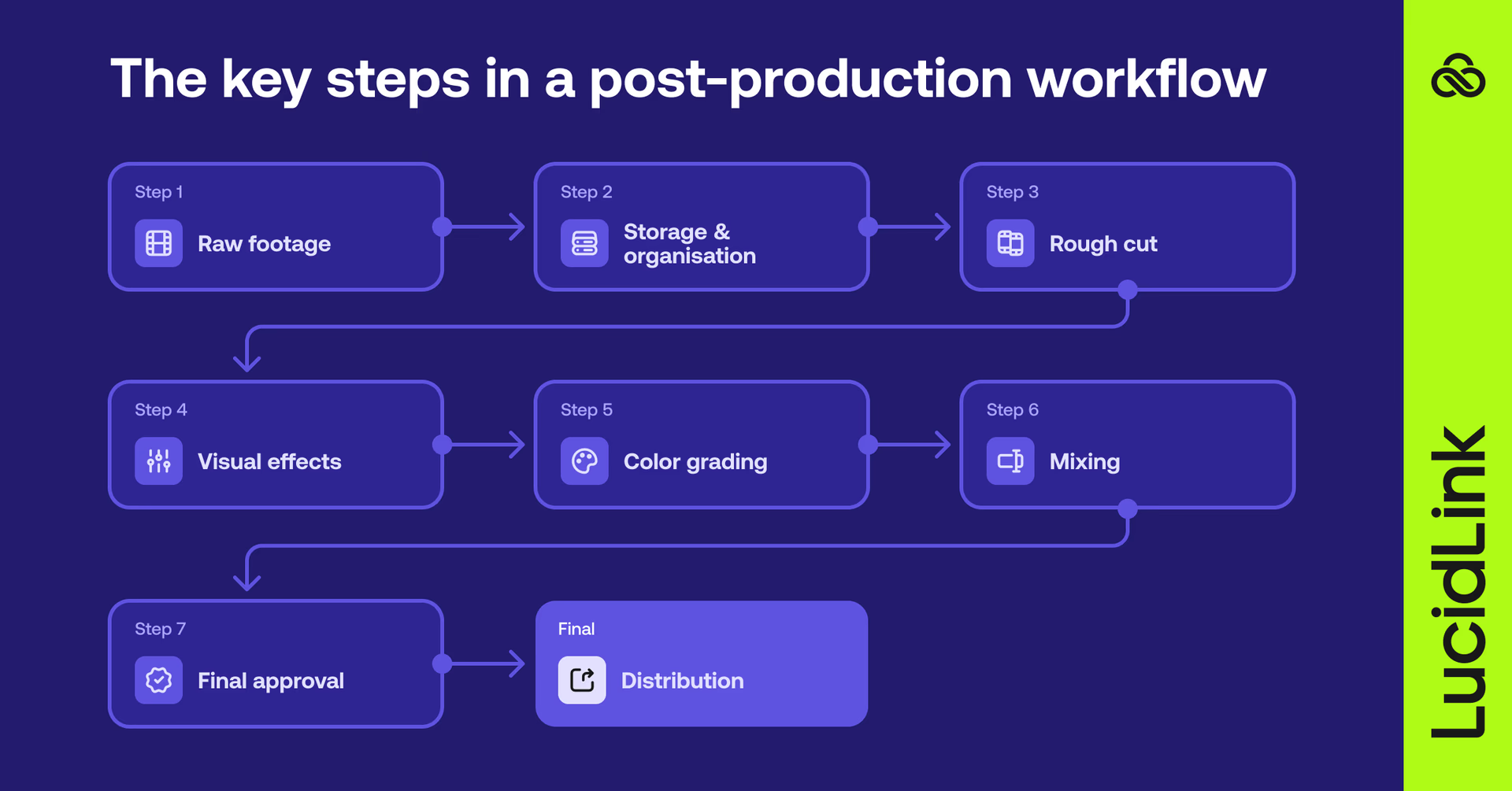
1. Raw footage management: the foundation of your workflow
The post-production clock starts ticking the second footage leaves the camera — not when it hits the edit suite. On big projects, media drops daily, so dailies need to move fast to steer on-set calls and keep the schedule from slipping.
But how do you share footage? Shipping hard drives is slow, risky and expensive — especially when every minute of footage could be worth thousands.
Save time by pushing footage to the cloud right after offload, so editors and colorists can start working, no matter their location.
Organizing video files for editing becomes much easier when everything is centralized and structured in a shared cloud workspace.
Pro tip: start with smart file naming. A clear naming convention before production begins can save hours later on, preventing chaos during editing and review.
2. Storage and organization: your post-production command center
Creative work can’t start until raw footage is stored and structured properly. Without a clear system, files get messy, confusion follows and delays (or costly mistakes) are guaranteed.
Sending huge video files back and forth is painfully slow. Duplicates create version chaos. And traditional storage like NAS, external drives, LTO tapes, simply doesn’t scale when your team’s scattered across time zones.
That’s where LucidLink comes in. It gives you the flexibility and security of cloud storage, but it feels just like working off a local drive. Teams can store and edit large files in real time, without downloads, waiting or juggling transfers. Everyone can jump into the same assets instantly, making your entire post-production workflow smoother and more efficient.
Pro tip: set up a clean folder structure from the start — think separate spots for raw footage, audio, graphics and project files. A little organization upfront saves a ton of headaches later.
3. Rough cut creation: shaping your narrative
With assets ready, it’s time to shape the story. The first cut sets the structure and flow, but revisions are inevitable. To avoid feedback chaos, set clear review stages early on. Know who’s giving input (and when) to prevent last-minute note-chasing.
If your team is spread out, sharing rough cuts can be a headache of giant files, slow transfers and constant exports.
LucidLink makes it easy. Editors can build and share cuts straight from the cloud, and stakeholders can jump into review right away with the waiting, downloads and file wrangling.
Editor's secret: start with a "selects" sequence where you gather all your favorite moments before building your rough cut. It helps you spot the strongest material early and makes the rest of the edit much smoother.
4. Visual effects integration: enhancing your storytelling
While the editing team shapes the narrative, VFX artists are working in parallel, layering in CGI, transitions and the visual magic that makes the story pop.
This part of the video post-production workflow only works if everyone’s in sync. Set up a clear VFX pipeline with defined handoff points so teams can stay aligned and know when it’s their turn to jump in.
But moving large VFX assets between teams can lead to long waits and version control nightmares. With LucidLink’s media cloud storage, VFX teams can drop finished assets directly into the collaborative workspace, where editors can access them instantly without transfers, re-uploads or physical shipping.
5. Color grading: finding your final look
This is where color grading works its magic. Smoothing out mismatched shots and dialing in the exact mood, from bold and vibrant to dark and dramatic.
It’s pretty common to have scenes shot under different lighting conditions. Maybe one character is bathed in sunlight while another’s under a cloudy sky. The whole point of grading is to make everything feel like it belongs together (frame by frame).
Before jumping into the full grade, create some reference frames for your key scenes. These act like a visual guide to keep the look consistent throughout the project.
Using LucidLink, colorists can work straight from the cloud with high-res files, eliminating the need to transfer massive media files.
Grading tip: consider making different grades for different platforms. What looks great in a theater might need tweaks to shine on a phone screen.
6. Audio mixing: shaping the soundscape
Great audio is the heartbeat of your story, dialogue, sound effects, music and every little ambient noise that sets the scene. When mixed right, it pulls everything together.
Start on sound early. Waiting for picture lock often means scrambling at the last minute. Clean and build your audio layers from the get-go.
A common snag? Sending audio files back and forth between editors, mixers, and directors can cause confusion and mix-ups.
With LucidLink, everyone works from the same files in real time, so there’s no guessing which version is the latest. It keeps your sound team in sync from the start.
Sound designer's tip: make a “sound bible” at the beginning — a document that outlines your project’s key sonic elements. It helps keep things consistent, especially if multiple people are mixing.
Learn more about streamlining your audio post-production workflow.
7. Final approval and distribution: delivering your vision
Once everything is locked (visuals, VFX, audio) it’s go time. But this is usually when last-minute change requests sneak in. Without a clear approval process, the post-production workflow can slow to a crawl.
Be clear about who gets the final call — and what happens if changes come in late.
Next up is distribution. And this is where things can get messy. Each platform, whether it’s theaters, streams, social or broadcast, has its own specs and hoops to jump through. It’s a lot to juggle.
With LucidLink, you can securely deliver final assets via encrypted cloud access, and keep everything organized for future remasters or re-deliveries.
Delivery hack: create a master checklist that covers all technical requirements for every platform. That way you can avoid costly mistakes or having to redo deliveries.
Cloud-based post-production workflows
The old ways of storing and sharing files don’t cut it anymore. Video post-production is global now and teams need content on-demand without delays.
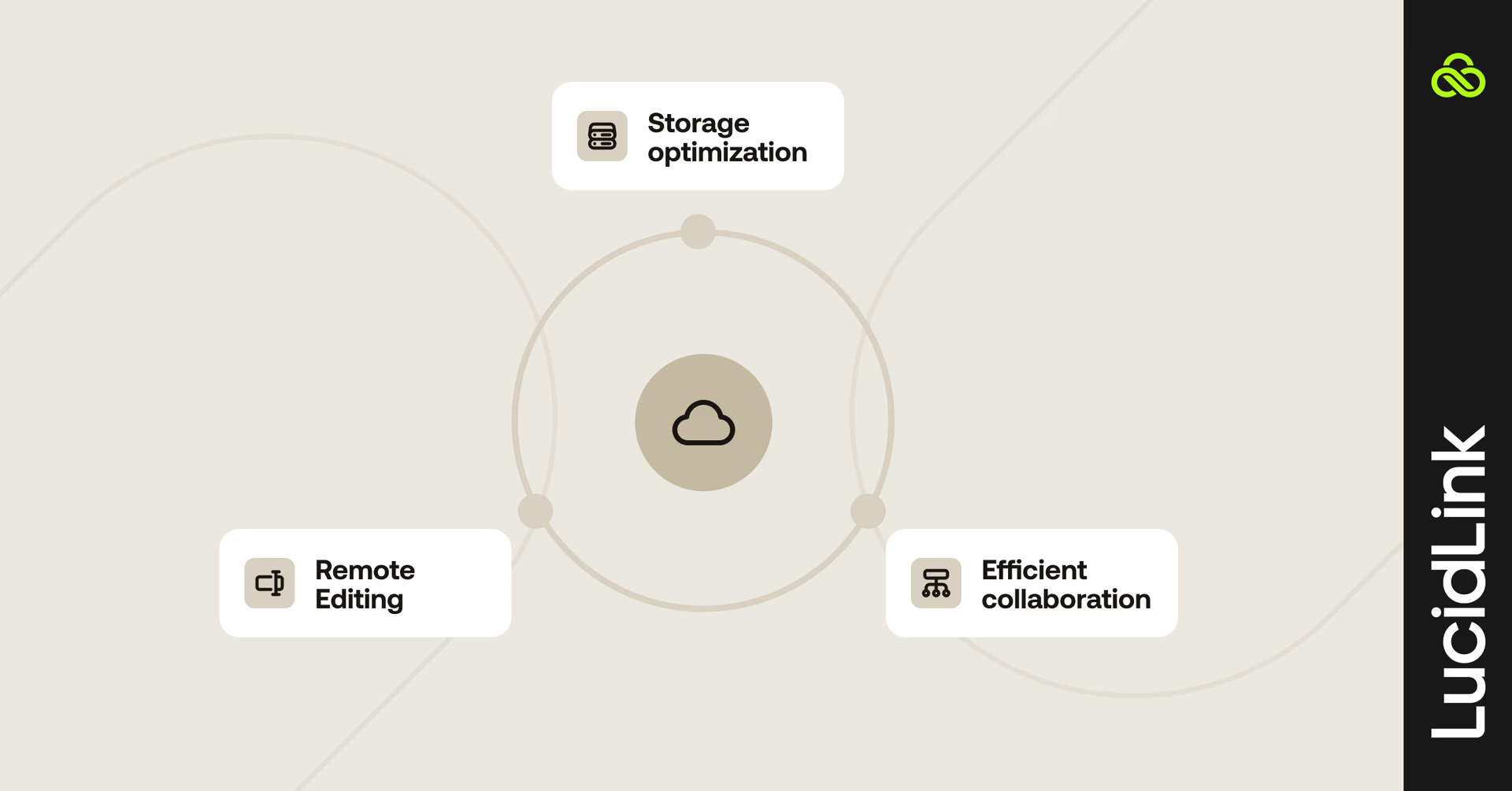
The wrong cloud solution will only multiply workflow challenges, like wasted time and storage silos. But the right one gives your team a new way of working:
Optimize storage costs by only paying for what they need while still getting lightning-fast access and strong security.
Edit remotely with collaborative video editing and work on the same files simultaneously without downloading content first.
Collaborate efficiently by accessing the same files simultaneously without duplicating efforts or chasing down the latest version.
Tools like Google Drive, Box and Dropbox aren’t designed for creative teams dealing with massive files and live version updates. That’s where a tailored solution steps in, transforming how post-production teams collaborate.
How LucidLink transforms your post-production workflow
LucidLink tackles the most significant challenges facing remote post-production teams:
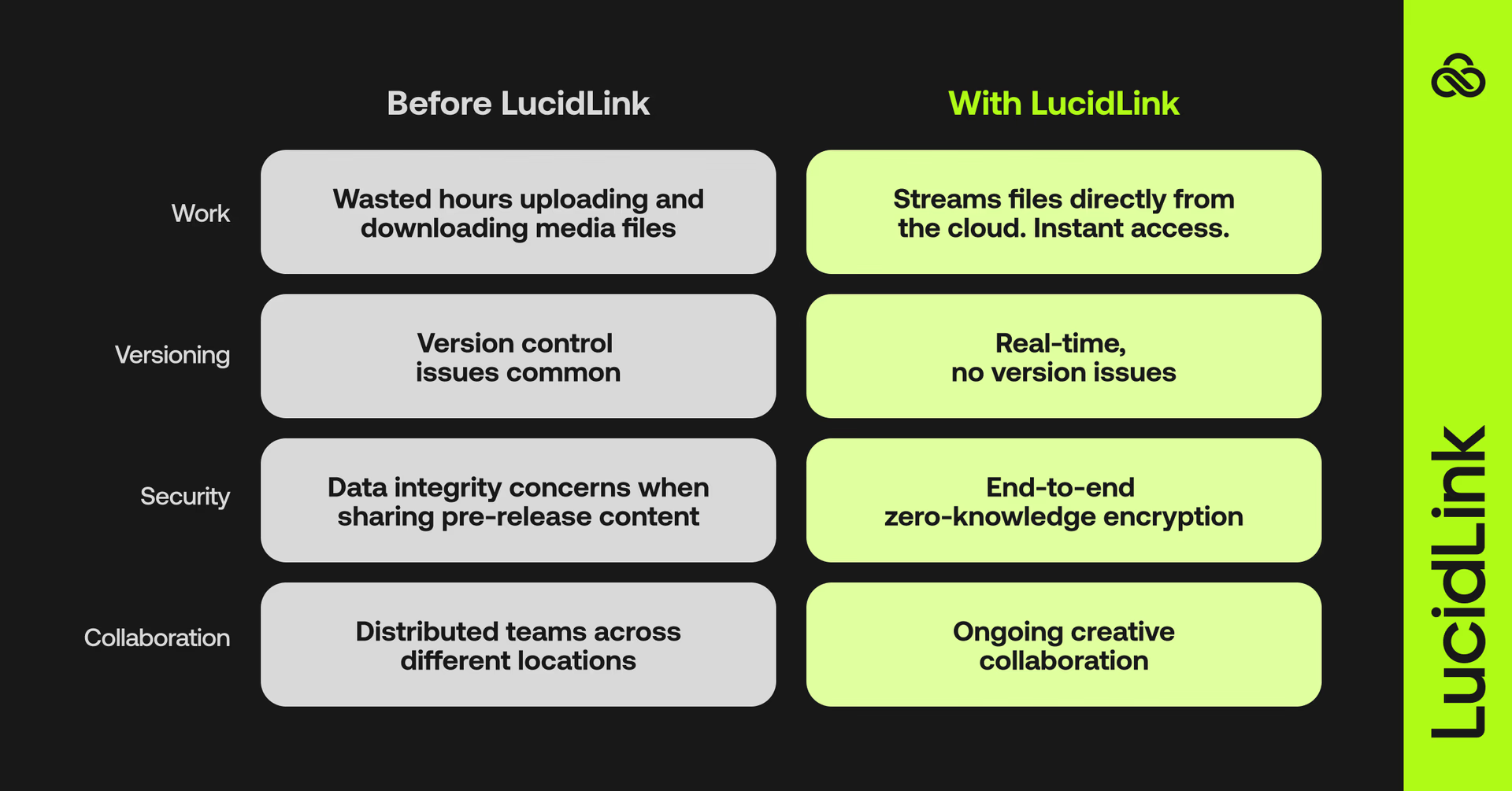
1. From waiting to working
Before LucidLink: wasted hours uploading and downloading media files, staring at progress bars instead of creating.
With LucidLink: instant access to media assets of any size without downloading or syncing first. Stream files directly from the cloud as if they're local, cutting out the wait so you can get straight to work.
"The time it used to take to download and upload files has all gone away." — Dennis Shin, VFX Creative Director
Learn how Bemo creates amazing animations while working from anywhere.
2. From version chaos to a single source of truth
Before LucidLink: multiple file versions, confusion about which is current and endless searching for the right assets.
With LucidLink: streamlined media asset management with a single source of truth. Everyone works from the latest version, every time — no more confusion or wasted effort.
"Our whole company can collaborate in real-time from anywhere in the world, off the cloud, as if they were connected to a local server." — Brian Sanford, Director of Post Production, Versus
3. From security concerns to zero-knowledge protection
Before LucidLink: worries about data integrity when sharing sensitive pre-release content.
With LucidLink: robust security and data integrity with zero-knowledge encryption. Unlike traditional cloud storage solutions, LucidLink ensures your data remains encrypted end-to-end. Your content stays safe whether it’s stored or being shared, so you can collaborate confidently, no matter where you are.
4. From disjointed teams to seamless collaboration
Before LucidLink: distributed teams struggling to keep video post-production workflows running smoothly across different locations.
With LucidLink: global creative teams working together simultaneously with the same experience as using a local drive. LucidLink integrates seamlessly into existing workflows without requiring teams to learn new tools or change their creative habits.
"We can have a 24-hour working day without a single editor having to work outside of normal hours, promoting greater productivity throughout the organization without compromising work/life balance. All just by having LucidLink as the backbone of our infrastructure. That's super important to us." — Katie Wade, US Head of Post Production, Casual
Learn more about how Casual powers a 24-hour global production cycle with LucidLink.
5 expert tips to optimize your post-production workflow
It’s not just about having the right tools. These tried-and-true strategies can help you get the most out of your post-production workflow:
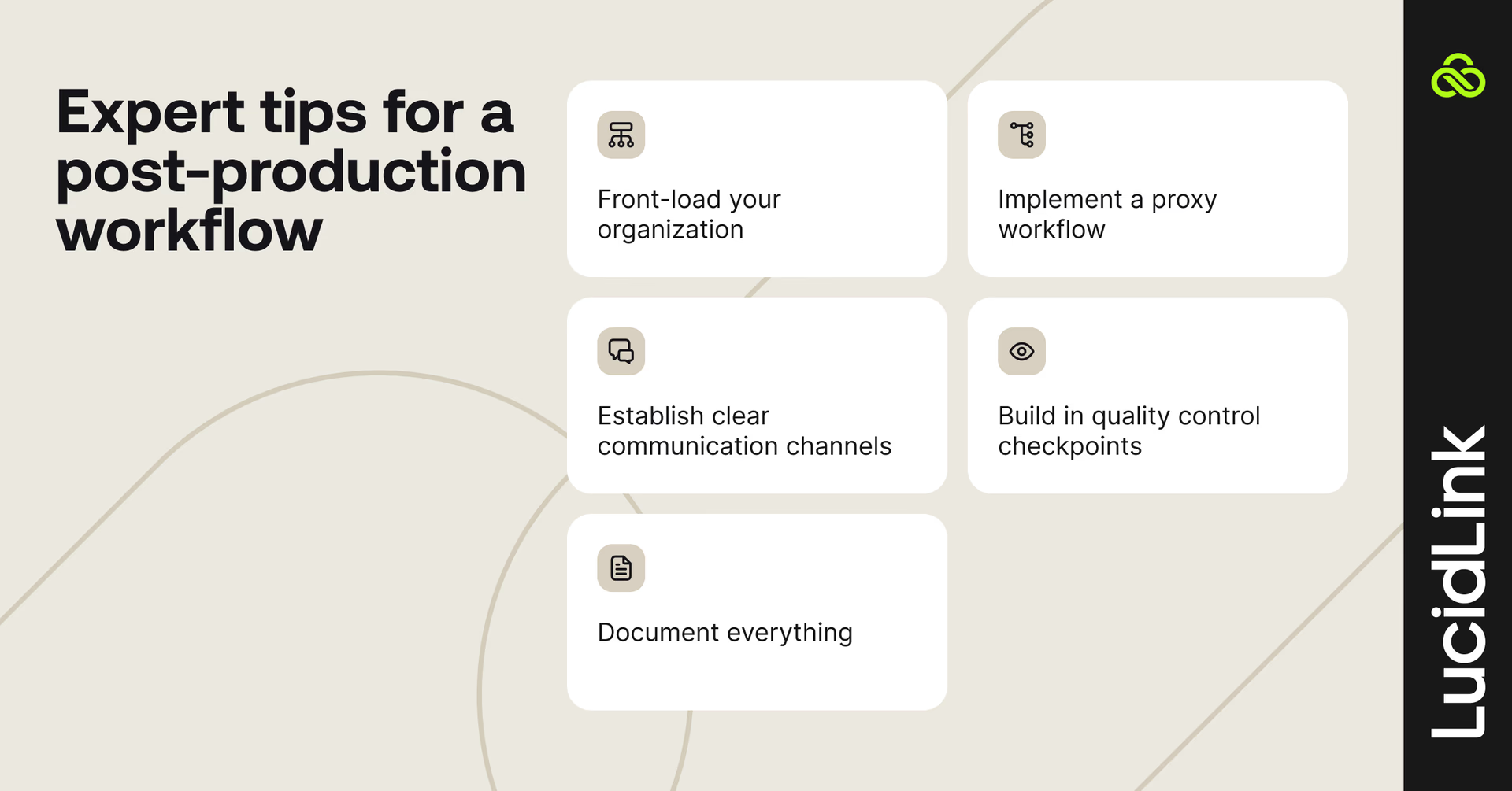
1. Front-load your organization
Take some time before editing starts to set up a clear project structure, naming system and media plan. Doing it upfront saves you a lot of trouble later on.
Pro tip: create project templates with standardized folder structures and color-coding systems that your entire team understands and follows consistently.
2. Implement a proxy workflow
For high-resolution content, create lower-resolution proxy files for editing while linking to the original media. In your post-production workflow, LucidLink lets you create these proxies right in the cloud, so editors can access them instantly without waiting around.
Pro tip: consider creating different proxy resolutions based on the editor's connection speed — higher resolution for those with fast connections, lower for remote video editing with bandwidth limitations.
3. Establish clear communication channels
Gather feedback from everyone into one clear set of action items to avoid mixed messages.
Communication hack: use frame-accurate review tools that integrate with your editing software to eliminate confusion about which specific moments need attention.
4. Build in quality control checkpoints
Schedule regular technical QC reviews throughout the post-production workflow, not just at the end. This prevents small issues from becoming major problems that require extensive rework.
QC focus areas: check for audio consistency, color calibration accuracy, subtitle/caption correctness and export settings alignment with delivery specifications.
5. Document everything
Create a go-to production guide that records all your technical decisions, asset locations and workflow processes. This resource becomes invaluable when onboarding new team members or troubleshooting issues.
Bonus benefit: easy-to-follow documentation makes your post-production workflow repeatable and scalable for future projects.
A post-production workflow in action: 50 films in 5 weeks
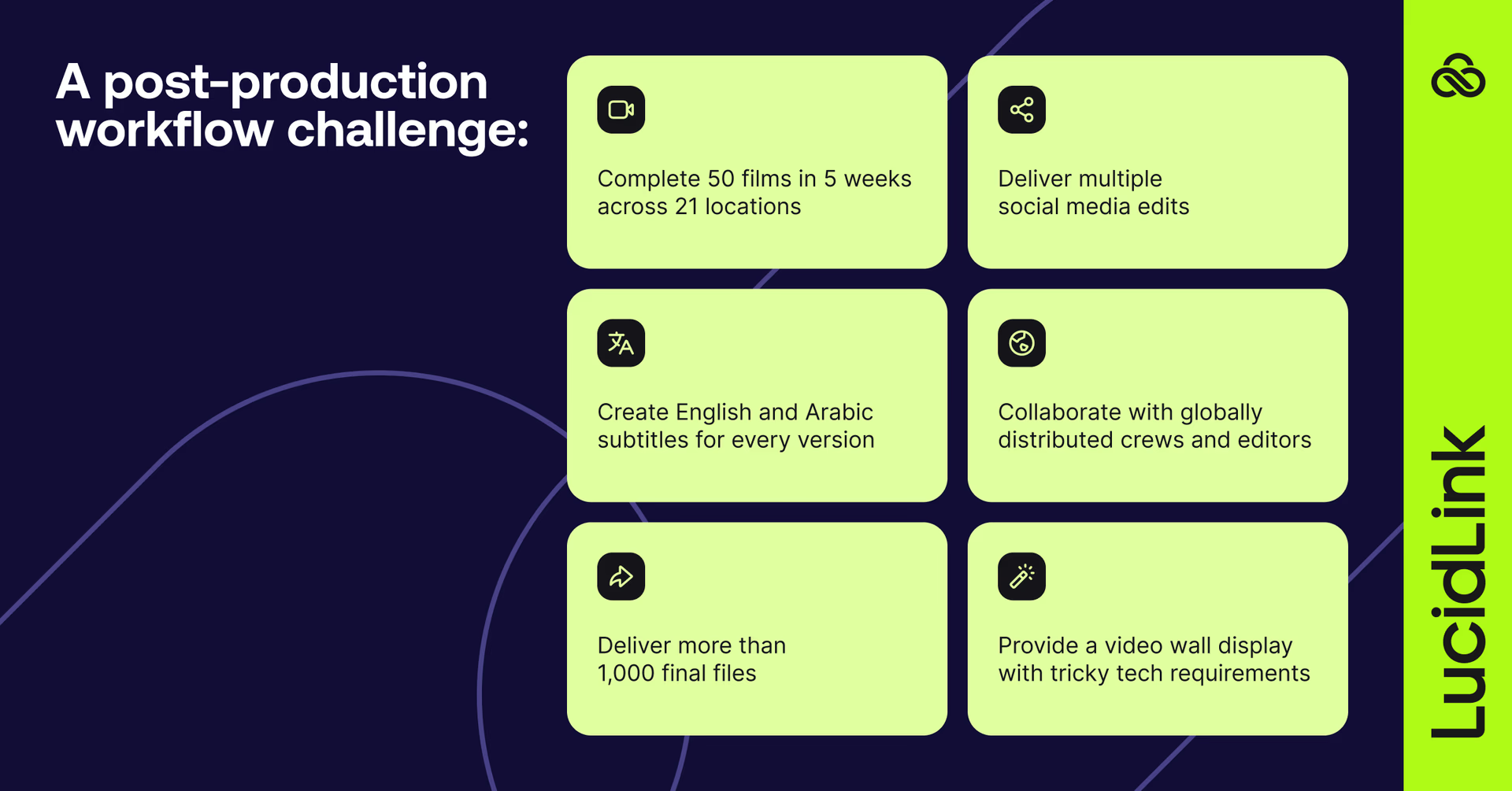
Imagine this: a big global government conference asks a creative agency to produce 50 short documentary films. And they want them all done in just 5 weeks.
The footage comes from five solo filmmakers spread across the globe, traveling from places like Honduras, Bhutan, Brazil and Finland, each capturing amazing stories in their own unique corners of the world.
That’s when Philip Owens, an experienced editor and workflow expert, stepped in. He turned to LucidLink to keep the whole remote post-production process running smoothly.
And guess what? The team pulled it off, delivering 50 polished films, plus over 1,000 versions for social media and different languages all on an insanely tight deadline.
The challenge: a massive project spread across 21 countries
Five filmmaking teams, loaded with top-tier gear like Canon C70s, Red Komodos and DJI drones, shot footage across 21 countries. Meanwhile, Philip’s editing crew was scattered across Brazil, New York, LA and London — all working remotely, without ever meeting in person.
Here’s what they had to tackle:
50 main documentary films
Loads of social media edits
English and Arabic subtitles for every version
A huge video wall display at the conference with tricky tech requirements
More than 1,000 final deliverables in total
How they did it: a 100% remote workflow
Philip’s team leaned on LucidLink. Combine that with Adobe Premiere Pro’s Productions feature, Google Docs for tracking and Frame.io for feedback, and you’ve got a recipe for smooth teamwork.
The filmmakers uploaded proxy footage via Starlink satellite internet directly into LucidLink. Editors around the world accessed those files instantly, as if they were sitting right next to the drives. No delays, no headaches. Just fast, seamless collaboration.
"LucidLink is really cool. It just mounts as a drive on your desktop. To the user, it's extraordinarily simple," says Philip.
Handling big data and complex deliverables
On top of all the films, the team created a jaw-dropping 360-degree video wall for the conference — a massive 30-foot tall screen, 13,000 pixels wide. This project combined dozens of layers of 4K footage, pushing the system to its limits — yet LucidLink handled it all flawlessly.
Final thoughts: remote work done right
Everyone on the team and the agency was amazed at how much they got done in such a short time.
Philip's final verdict? "I don't think this would have been possible without LucidLink. I really don't. They've built an amazing system."
This project proves that with the right tools, creative teams can pull off huge, complex productions — all without ever stepping into the same room.
Read the full story here.
Post-production workflow software and tools
The right video collaboration tools can dramatically impact your post-production workflow efficiency. Here's a quick overview of essential software for each stage:
Editing platforms
Adobe Premiere Pro: industry-standard for versatility
Avid Media Composer: preferred for long-form narrative content
DaVinci Resolve: powerful all-in-one solution with superior color tools
Final Cut Pro: popular for its speed and optimization on Mac systems
Color grading
DaVinci Resolve: the gold standard for professional color work
Colorfront OSD: popular for high-end dailies color
FilmLight: renowned for advanced color grading in feature films and high-end TV
See how FilmLight and LucidLink combine to make remote color grading workflows simple
Audio post
Pro Tools: industry standard for professional audio post
Logic Pro: popular alternative for music-focused projects
Adobe Audition: integrates well with Premiere Pro workflows
Creative asset management
LucidLink: cloud-native file access and collaboration
Frame.io: review and approval workflow
Organizer within editing platforms
Remote collaboration
LucidLink: real-time access to media from anywhere
Evercast/Sohonet ClearView: real-time review sessions
ftrack/Shotgrid: production tracking and management
LucidLink integrates seamlessly with these tools, enabling cloud video editing without forcing teams to change their preferred software.
How long does post-production usually last?
The duration of post-production varies significantly based on project type and complexity:
Commercials: 1-4 weeks
Corporate/Marketing videos: 2-6 weeks
Short films: 4-12 weeks
Feature films: 3-9 months
TV episodes: 2-6 weeks per episode
High-end series: up to several months per episode
Critical factors affecting timeline:
Complexity of visual effects
Amount of footage to process
Required approval rounds
Number of deliverables
Team size and expertise
With LucidLink, you can cut down those long waits for file transfers and make teamwork smoother, giving you back hours of creative time every day.
Savings Calculator
Every second counts
See exactly how much time and money your team could save with LucidLink.

The future of post-production workflows
As production technology moves forward, post-production workflows are going full cloud and spreading across the globe.
Key trends shaping the future include:
Collaborative video editing across continents without quality compromise
AI-assisted editing for initial assembly and mundane tasks
Virtual production blurring the lines between production and post
Remote dailies processing happening simultaneously with shooting
Cloud-native workflows replacing traditional infrastructure
LucidLink is at the forefront of this evolution, enabling truly distributed post-production workflows that were impossible just a few years ago. Learn more about the future of post workflows in this virtual event with LucidLink and Projective.
Ready to transform your post-production workflow?
Stop waiting and start creating. Life’s too short for slow, outdated workflows.
With LucidLink, you can streamline your post-production, collaborate in real-time and reclaim hours of creative time daily. Want to see for yourself? Sign up for a free trial today.
FAQs
Post-production is the step-by-step process of turning raw footage into a finished video, covering file organization, editing, VFX, color, audio and final delivery. A streamlined workflow keeps teams aligned and projects on track.
Start with clear file organization and naming. Use collaborative tools like LucidLink to let editors and VFX teams work on the same files in real time, and set review milestones to avoid revision chaos.
It’s often due to disorganized files, slow transfers, and scattered feedback loops. A cloud-first workflow — where teams work directly from shared storage like LucidLink — removes these bottlenecks in post-production.
Absolutely. With the right cloud platform, editors and VFX teams can collaborate on high-res files from anywhere. LucidLink lets teams work on the same media without downloading or transferring files.
Common mistakes include poor file organization, slow file transfers, unclear feedback steps and version confusion. Centralizing files in a shared cloud workspace helps teams stay in sync and avoid these issues.
You need more than basic cloud storage. Platforms like LucidLink let teams stream large media files directly from the cloud, so editors and VFX artists can work instantly — no downloads or delays.
Keep reading

Creative production
Audio post-production: everything you need to know
Audio post-production brings performances, effects, music, and mixing together to make your story come alive. Explore the full workflow and tips here.
13 October 2025, 12 mins read

Creative production
17 marketing agency tools that make teams more brilliant (and clients happier)
Discover the 17 best marketing agency tools to streamline workflows, boost collaboration and grow your digital marketing agency.
10 October 2025, 13 mins read

Creative production
How to organize video files for editing (and stop chaos before it starts)
Discover how to organize video files for editing with smart strategies and tips to streamline your workflow.
23 September 2025, 8 mins read
Join our newsletter
Get all our latest news and creative tips
Want the details? Read our Privacy Policy. Not loving our emails?
Unsubscribe anytime or drop us a note at support@lucidlink.com.